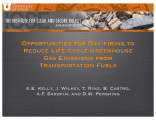TO
Filters: Research Institute: "Institute for Clean and Secure Energy (ICSE)" School Or College: "University of Utah" Collection: "ir_eua"
| Title | Date | Subject | Description | ||
|---|---|---|---|---|---|
| 51 |
 |
Lands with wilderness characteristics, Resource Management Plan constraints, and land exchanges: Cross-jurisdictional management and impacts on unconventional fuel development in Utah's Uinta Basin | 2012-03 | Utah oil shale; oil sands; unconventional fuel resources; land exchanges; land rights | Utah is rich in oil shale and oil sands resources. Chief among the challenges facing prospective unconventional fuel developers is the ability to access these resources. Access is heavily dependent upon land ownership and applicable management requirements. Understanding constraints on resource acce... |
| 52 |
 |
North-South core-based cross section through the middle to upper Green River Formation, Uinta Basin, Utah - Plate 2 | 2014 | oil shale; economic oil shale; oil shale zone; cross section; Green River Formation; well log; core log | The top of economic oil shale was picked at the top of the lower R-8 zone (top of the Big Three rich oil shale beds). This zone was selected to avoid the abundant saline minerals found in the overlaying saline zone, which often contains high-TDS water. If saline minerals (and high-TDS water) do not ... |
| 53 |
 |
Opportunities for oxy-firing to reduce life-cycle greenhouse gas emissions from transportation fuels | 2011-03-10 | GHG; oxy-firing; reduce greenhouse gas emissions; transportation fuel emissions; CO2 analysis; oil sands | The outline covers in this presentation covers: GHGs and the transportation fuel cycle. Motivation for reducing GHG emissions. Use of oxy-firing for CO2 capture in refining of conventional fuel. Use of oxy-firing for extraction and upgrading of oil sands. GHG emissions from other scenarios Would oxy... |
| 54 |
 |
Oxy-coal combustion studies - Task 3 topical report, Utah Clean Coal Program. | 2014-08 | oxy-coal combustion; Utah Clean Coal Program; oxy-coal; large eddy simulations; near-flame aerodynamics; pilot-scale oxy-CFB; single-particle oxy char oxidation; ash partitioning; carbon capture; pulverized coal-fired power plants | The objective of this task is to move toward the development of a predictive capability with quantified uncertainty bounds for pilot-scale, single-burner, oxy-coal operation. This validation research brings together multi-scale experimental measurements and computer simulations. The combination of s... |
| 55 |
 |
Oxy-coal Combustion Studies Task 3 Topical Report, Utah Clean Coal Program | 2012-01-06 | oxy-coal combustion; Utah Clean Coal Program; carbon capture; large eddy simulations; near-field aerodynamics of oxy-coal flames; single-particle oxy-CO2 combustion; ash partitioning | The objective of this project is to move toward the development of a predictive capability with quantified uncertainty bounds for pilot-scale, single-burner, oxy-coal operation. This validation research brings together multi-scale experimental measurements and computer simulations. The combination o... |
| 56 |
 |
Oxy-fuel hierarchy | 2009-11-04 | oxy-fuel combustion; different fuel types; ICSE | Hierarchical chart for the oxy-fuel combustion research area showing connectivity between subtasks. This research area includes coal, gas, and oil oxy-burner technologies. This chart helps illustrate the integration and focus among the different fuel types and different scales represented in the hie... |
| 57 |
 |
Oxy-gas process heaters for efficient CO2 capture | 2010-04-28 | oil shale and oil sands technology; greenhouse gas emissions; GHG; large eddy simulation; LES; IFRF OXYFLAM | Implementation of oil shale/sands technologies in U.S. will require mitigation of greenhouse gas (GHG) emissions. |
| 58 |
 |
P4 Plate 6 | 2014 | well log; core log; plate 6; P4; White River Shale Project; Green River Formation | |
| 59 |
 |
Phase 2: Clean and secure energy from coal: Quarterly progress report: April 1, 2010 to June 30, 2010 | 2010-08-01 | domestic coal resources; CO2 capture; stationary power generation; DQMOM approach | The University of Utah is pursuing research to utilize the vast energy stored in our domestic coal resources and to do so in a manner that will capture CO2 from combustion from stationary power generation. The research is organized around the theme of validation and uncertainty quantification throug... |
| 60 |
 |
Phase 2: Clean and secure energy from coal: Quarterly progress report: January 1, 2010 to March 31, 2010 | 2009-01-30 | domestic coal resources; ICSE; capture CO2; stationary power generation; velocity model; bitumous coal; coal | The University of Utah is pursuing research to utilize the vast energy stored in our domestic coal resources and to do so in a manner that will capture CO2 from combustion from stationary power generation. The research is organized around the theme of validation and uncertainty quantification throug... |
| 61 |
 |
Phase 2: Clean and secure energy from coal: Quarterly progress report: July 1, 2010 to September 30, 2010 | 2010-10-01 | domestic coal resources; CO2 capture; stationary power generation; Oxycoal; OFC; coal | The University of Utah is pursuing research to utilize the vast energy stored in our domestic coal resources and to do so in a manner that will capture CO2 from combustion from stationary power generation. The research is organized around the theme of validation and uncertainty quantification throug... |
| 62 |
 |
Phase 2: Clean and secure energy from coal: Quarterly progress report: October 1, 2009 to December 31, 2009 | 2010-01-30 | domestic coal resources; CO2 capture; stationary power generation; oxy-coal flames; coal gasification process | The University of Utah is pursuing research to utilize the vast energy stored in our domestic coal resources and to do so in a manner that will capture CO2 from combustion from stationary power generation. The research is organized around the theme of validation and uncertainty quantification throug... |
| 63 |
 |
Phase 2: Clean and secure energy from coal: Quarterly progress report: October 1, 2010 to December 31, 2010 | 2011-01-31 | domestic coal resources; CO2 capture; stationary power generation; LES; DQMOM approach; oxy-coal flames; coal | The University of Utah is pursuing research to utilize the vast energy stored in our domestic coal resources and to do so in a manner that will capture CO2 from combustion from stationary power generation. The research is organized around the theme of validation and uncertainty quantification throug... |
| 64 |
 |
Policy analysis of produced water issues associated with in-situ thermal technologies: Topical report: October 1, 2009 to December 31, 2010 | 2011-01 | topical report; produced water issues; in situ thermal technologies; oil shale/sands; water rights; domestic energy source | Commercial scale oil shale and oil sands development will require water, the amount of which will depend on the technologies adopted and the scale of development that occurs. Water in oil shale and oil sands country is already in scarce supply, and because of the arid nature of the region and limita... |
| 65 |
 |
Policy analysis of the Canadian oil sands experience | 2011-03-10 | policy analysis; Canadian oil sands experience; oil sands; federal oil sands resources; oil sands development; unconventional fuels | The presentation goes over analyzing the relevance of the Canadian experience to U. S. oil sands development. This report focuses on federal oil sands resources, specifically potential development in the STSA's. No Current development on federal lands, despite leasing authorization under the Combine... |
| 66 |
 |
Policy analysis of water availability and use issues for domestic oil shale and oil sands development: Topical Report: October 1, 2009 to March 31, 2010 | 2010-03 | oil shale/sands resources; energy source; unconventional fuels; water demands; water availability; domestic oil shale/sands development; topical report | Oil shale and oil sands resources located within the intermountain west represent a vast, and as of yet, commercially untapped source of energy. Development will require water, and demand for scarce water resources stands at the front of a long list of barriers to commercialization. Water requiremen... |
| 67 |
 |
Policy issues associated with using simulation to assess environmental impacts | 2014-11 | oil and natural gas technology; policy issues with using simulation; environmental impacts; simulation-based science; judicial assessments and models; environmental policymaking | This report examines the relationship between simulation-based science and judicial assessments of simulations or models supporting evaluations of environmental harms or risks, considering both how it exists currently and how it might be shaped in the future. This report considers the legal standard... |
| 68 |
 |
Pore scale analysis of oil sand/oil shale pyrolysis by X-ray Micro CT and LB simulation | 2010-04-28 | unconventional fuels; characterization of the pore networks; oil sand/shale resources; LB simulation; pyrolysis reations; Multiscale X-ray Micro/Nano Tomography | The research objectives include (1) CT characterization of the pore network structure for selected oil sand/oil shale resources, (2) LB simulation of flow through pore network structures to predict transport properties, such as permeability, and (3) CT analysis of pore network structure during pyrol... |
| 69 |
 |
Pore scale analysis of oil sand/oil shale pyrolysis by X-ray Micro CT and LB simulation | 2010-03-03 | pore scale analysis; oil sand/shale pyrolysis; X-ray Micro CT and LB simulation; Lamellar Structure of Oil Shale | The research objectives include (1) CT characterization of the pore network structure for selected oil sand/oil shale resources, (2) LB simulation of flow through pore network structures to predict transport properties, such as permeability, and (3) CT analysis of pore network structure during pyrol... |
| 70 |
 |
Pore scale analysis of oil shale pyrolysis by X-ray CT and LB simulation | 2010-09-09 | pore scale analysis; oil shale pyrolysis; X-ray CT; LB simulation; oil shale; shale oil procuction; pore structure | There are important questions concerning the quality and volume of pore space that is created when oil shale is pyrolyzed for the purpose of producing shale oil. In this paper, we pyrolyzed 1.9 cm diameter cores at different temperatures and heating rates. Detailed 3D imaging of the core before and ... |
| 71 |
 |
Pore scale analysis of oil shale/sands pyrolysis | 2011-03-31 | pore scale analysis; oil shale/sands pyrolysis; shale oil production; domestic oil shale deposits | There are important questions concerning the quality and volume of pore space that is created when oil shale is pyrolyzed for the purpose of producing shale oil. In this report, 1.9 cm diameter cores of Mahogany oil shale were pyrolyzed at different temperatures and heating rates. Detailed 3D imagin... |
| 72 |
 |
Rates and mechanisms of oil shale pyrolysis: A chemical structure approach | 2014-11 | Green River oil shale; oil and natural gas technology; oil shale pyrolysis; chemical structure of oil shale | Three pristine Utah Green River oil shale samples were obtained and used for analysis by the combined research groups at the University of Utah and Brigham Young University. Oil shale samples were first demineralized and the separated kerogen and extracted bitumen samples were then studied by a host... |
| 73 |
 |
Red Wash 1 (U045) - Plate 8 | 2014 | plate 8; Red Wash 1; well log; core log; Green River Formation | |
| 74 |
 |
Redwash 1 XRF depth plots | 2014 | depth plots; Green River Formation; XRF | |
| 75 |
 |
Regulatory promotion of emergent CCS technology - Topical report | 2014-01 | CCS technology; climate change; mitigation strategies; carbon capture and sequestration | Despite the growing inevitability of climate change and the attendant need for mitigation strategies, carbon capture and sequestration (CCS) has yet to gain much traction in the United States. Recent regulatory proposals by the U.S. Environmental Protection Agency (EPA), limited in scope to new-buil... |
